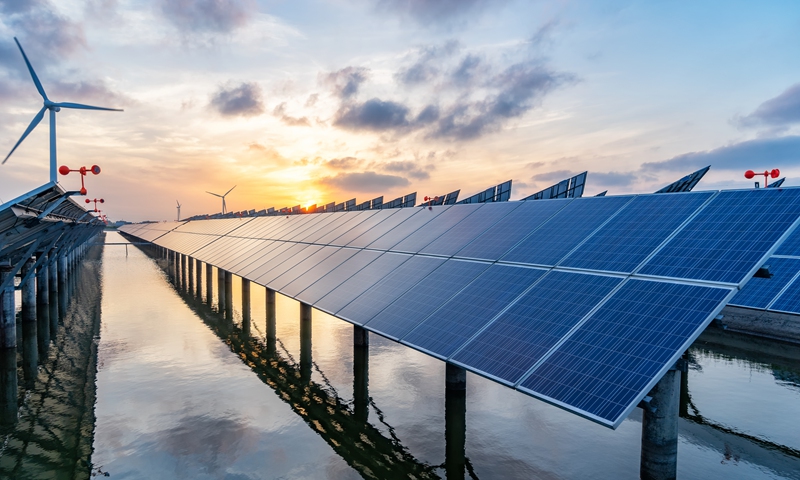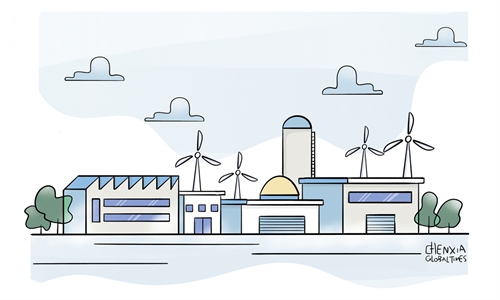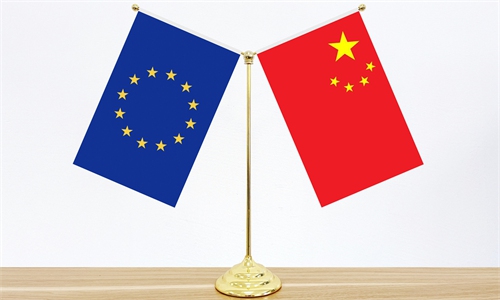China's capacity remains a strong engine for global energy transition: Global Times editorial

Photovoltaic panels in Sihong, East China's Jiangsu Province Photo: VCG
The 26th World Energy Congress has been held in Rotterdam, the Netherlands, in recent days. As one of the most important conferences in the field of energy, the conference is themed "Redesigning Energy for People and Planet," and attracted nearly 20,000 representatives from the global energy sector to discuss the energy transition, security, accessibility and sustainability in the current world.
This year marks the 100th anniversary of the World Energy Congress. The world is at a crucial turning point in energy transition, which is recognized by the industry as a key moment for proposing and implementing major changes. The conference provides timely information for the general public to understand the current situation of the global energy transition.
Undoubtedly, the most prominent issues and concerns throughout the Congress remain the challenges posed by climate change and the urgency and uncertainty of energy transition. Specifically, it is about how to address the "trilemma" of global energy security, affordability, and sustainability, and to realize a faster, fairer and broader energy transition. Throughout the world, considering the target of achieving the Paris Agreement's goal of limiting the temperature increase, and achieving the carbon peaking and neutrality commitments made by many countries, the current global resource inputs in the field of energy transition and clean energy, as well as the related supply of green and low-carbon products, are far less than the demand.
Against this background, the current hyping by the US and some other Western countries about "overcapacity" in China's solar panels and electric vehicles (EVs), and their attempts to build trade barriers in the clean energy sector, have also received attention and been discussed. Among them, Saudi Aramco CEO Amin Nasser's relevant remarks have particularly triggered attention and resonance. Nasser spoke highly of China's key role in driving the global energy transition at the World Energy Congress, noting in particular that China will substantially help Western countries achieve their target of cutting carbon emissions to a net zero level by lowering the cost of solar panels and electric vehicles.
Nasser's remarks have attracted attention not only because of his own status and Saudi Aramco's special position in the energy field, but also because of his fair assessment of China's efforts in clean energy and global emissions reduction. China's capacity and technological breakthroughs in the clean energy sector have become a powerful engine driving global energy transition. According to statistics, over the past 10 years the average electricity costs of global wind and photovoltaic projects have cumulatively decreased by over 60 percent and 80 percent, respectively, with a considerable portion attributed to China's contributions. Leveraging its vast market scale, efficient supply chain management, and technological innovation capabilities, China has successfully reduced the costs of solar panels and EVs significantly, enhancing the affordability of these new energy products. This not only reduces its own carbon emissions but also provides global consumers with more economical and environmentally friendly choices.
The transition of energy is not an easy task. It is both extremely urgent and exceptionally complex, requiring a comprehensive strategic approach. The appreciation from Saudi Aramco, represented by Nasser, toward China stems from the recognition by Saudi Arabia, other Middle Eastern countries, and many other developing nations of China's indispensable role in energy transition. For instance, the Al Shuaibah photovoltaic power station project constructed by Chinese enterprises in Saudi Arabia will, upon completion, reduce carbon dioxide emissions by 245 million tons in 35 years, equivalent to planting 545 million trees. In 2022, the wind and photovoltaic products exported by China helped other countries reduce carbon dioxide emissions by approximately 573 million tons, totaling 2.83 billion tons of carbon reduction, accounting for about 41 percent of the global carbon reduction volume brought by renewable energy during the same period.
However, considering the urgent global situation in addressing climate change and the current status of green capacity in various countries, whether it is achieving the goals of the Paris Agreement globally or China achieving its own "dual-carbon" goals, China's current green capacity still falls far short of meeting the needs. The International Energy Agency (IEA) has warned that the current use of fossil fuels remains "excessive." In this context, the challenge facing humanity is not an "overcapacity" of green production but a severe shortage. China's green capacity is undoubtedly the "magic weapon" for addressing challenges, and displacing high-quality capacity is irrational. It is the optimal solution for global emission reduction to enable China's green capacity to play to its strengths and complement and coordinate cooperation with the capacities of other countries.
The US and some countries, from the perspective of protecting their own industries and suppressing Chinese advantageous industries, attempt to stifle the development of China's clean energy industry with the so-called "overcapacity" narrative. However, from a global perspective, especially from the standpoint of many developing countries and the "Global South," this undermines the goal of a faster, fairer and more widespread energy transition. Faced with the common challenge of climate change, promoting energy transition should uphold an open and cooperative attitude, rather than getting bogged down in futile trade disputes and blame games, otherwise it will only hinder the pace of global energy transition.


